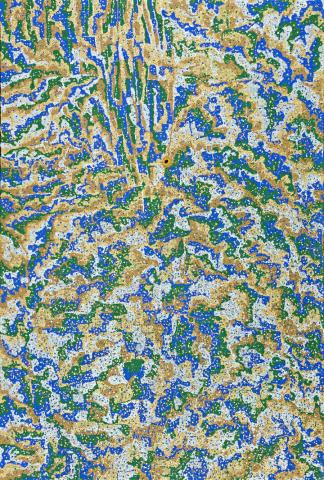KIRRIWIRRI, 2007
DANIEL WALBIDI
synthetic polymer paint on linen
167.0 x 111.0 cm
inscribed verso: artist's name, medium, size, date and Short Street Gallery cat. 25005
Short Street Gallery, Broome
Private collection, New South Wales
25th Silver Jubilee Telstra National Aboriginal and Torres Strait Islander Art Award, Museum and Art Gallery of the Northern Territory, Darwin, 15 August – 26 October 2008, cat. 49
This work is accompanied by a certificate of authenticity from Short Street Gallery which states: 'Daniel Says: Kirriwirri is my grandfathers country. Kirriwirri is near Well 33 on the Canning stock route in the Great Sandy Desert in Western Australia. Our clan is also names Kirriwirri, and call each individual members of this clan Kirriwirri. There is a big Warla (mud flat) at this place. It is a very important place.'
Densely worked and shimmering with rich metallic colour, Kirriwirri is a lyrical example of Daniel Walbidi's work. Having commenced painting in his teenage years, Walbidi's complex visual language has developed significantly over the past decade. Now highly sought after, his paintings have been exhibited in Japan, the United States of America and the United Kingdom. Representing the distillation of country, ancestral mythology and a very contemporary sensibility, the works reveal an acute interest in how to present and share the depth and complexity of Aboriginal culture with a wider non-Aboriginal audience.
In an interview published in the launch issue of Australian Aboriginal Art, Daniel Walbidi described his approach to the landscape, and to painting, thus:
'The landscape is never flat. It is layered and what you see if only part of what you know about the country. When you paint, I think it is important to use all your knowledge and all your senses, not just sight. Painting is not just limited to what you see. This one of the great limitations of early Western paintings of the bush is that they just painted what they saw. They only used one sense. I like to paint with all my senses, my intellect and most of all with my liyan (heart). The desert is ancient and rich in stories. There are so many different types of plants and foods, and in the Great Sandy Desert there are aquifers and big rivers running underneath the ground. The landscape changes every day with every season. My paintings are so dense and layered because I like to get the essence of this country. I love using colour and mixing paints, and I like all the tonal variations. These are things that you see in the desert all the time. Every colour imaginable is present. My whole psyche is filled with colour and that is integral to my paintings.'1
The specific introduction of metallic paints into the artist's palette has its inception in a journey undertaken in 2007 by Walbidi and his father. They flew to Winpa, the aerial perspective revealing for the first time the geological intricacy of the landscape and transforming the manner in which Walbidi perceived depth and tonality. Of the experience, Walbidi comments, 'When we flew over that country it was in the middle of the day and the sun was shining directly onto the lakes. I realised that they were not white, but silver and the sand dunes were full of gold.'2
1. Emily Rohr interview with Daniel Walbidi in Australian Aboriginal Art, Issue 1, March/April/May 2009, p. 94
2. ibid.
MERRYN SCHRIEVER
